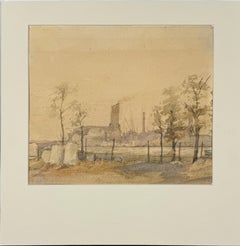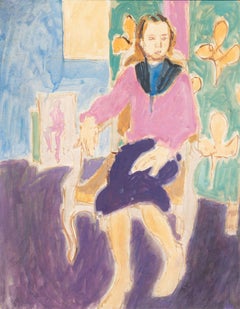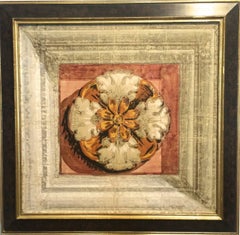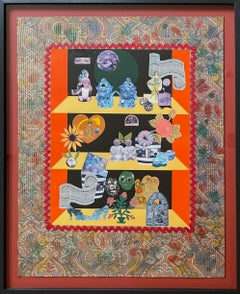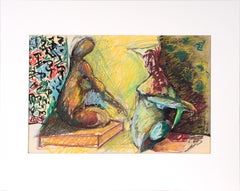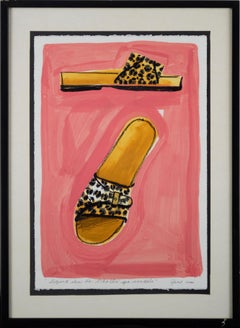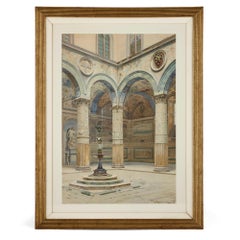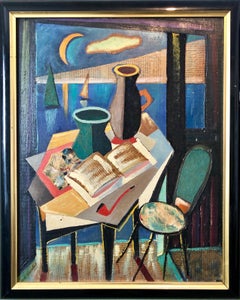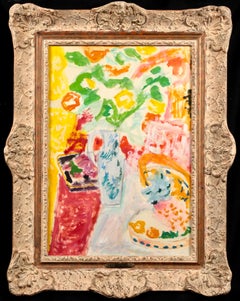Laid Paper Interior Paintings
to
2
2
3
3
Overall Width
to
Overall Height
to
2
4
2
1
1
1
3
4
3
1
5
5
3
2
1
1
1
1
1
1
1
1
1
1
1
1,057
7,524
5,043
4,020
3,866
1
1
1
1
3
7
1
Medium: Laid Paper
Mill with Masted Ships in a Harbor Original Watercolor
Located in Soquel, CA
Mill with Masted Ships in a Harbor Original Watercolor
Early Watercolor of a coastal Mill with Schooners in a harbor, by an unknown artist. 1890-1915. The image depicts a watercolor...
Category
Late 19th Century Impressionist Laid Paper Interior Paintings
Materials
Watercolor, Laid Paper
'Woman Seated', Louvre, LACMA, Académie Chaumière, California Post-Impressionist
Located in Santa Cruz, CA
Estate stamp, verso, for Victor Di Gesu (American, 1914-1988) and painted circa 1955.
Winner of the Prix Othon Friesz, Victor di Gesu first attended the Los Angeles Art Center and t...
Category
1950s Laid Paper Interior Paintings
Materials
Gouache, Laid Paper
19th Century Italian Floral Wallpaper Painting
Located in Lake Worth Beach, FL
Architectural Floral Wallpaper Fragment
19th Century Italian hand painted floral design wallpaper lined with linen, in gold leaf wood framed as is.
Category
19th Century Italian School Laid Paper Interior Paintings
Materials
Watercolor, Gouache, Laid Paper, Linen
$1,200 Sale Price
20% Off
Mediterranean Still Life Abstract Interior painting of flowers in a yellow vase
Located in Shrewsbury, Shropshire
In this composition, Halliday captures the quiet elegance of a presbytery interior, likely situated in a French setting, given his frequent explorations of European locales. The arra...
Category
21st Century and Contemporary Impressionist Laid Paper Interior Paintings
Materials
Watercolor, Laid Paper
Cabinet, unique signed mixed media fem-mage by pioneering Pattern & Decoration
Located in New York, NY
Miriam Schapiro
Cabinet, 1999
Fabric, Rickrack, photography, magazine images, greeting cards, lithography, collage, text
Hand Signed and dated by the artist on the lower right front
...
Category
1990s Feminist Laid Paper Interior Paintings
Materials
Fabric, Mixed Media, Laid Paper, Lithograph
Seeking Advice from the Buddha - Figurative in Pastel on Paper
Located in Soquel, CA
Seeking Advice from the Buddha - Figurative in Pastel on Paper
Brightly colored figurative composition by Michael William Eggleston (American, 20th Century). An abstracted figure is...
Category
21st Century and Contemporary Futurist Laid Paper Interior Paintings
Materials
Oil Pastel, Laid Paper
Still Life with Succulent Meditation
By Noel Howard
Located in Soquel, CA
Still life with succulent on a royal blue tile floor, with a section of an oriental rug, pillows, and a mug of tea visible in the periphery by Noel Howard (American, 20th Century). S...
Category
1970s American Impressionist Laid Paper Interior Paintings
Materials
Conté, Crayon, Laid Paper
A Game of Patience, 1900 Watercolor by RFB Frederick McNamara Evans
Located in Grand Rapids, MI
Frederick McNamara Evans (English, 1859-1929)
Signed: F.M. Evans (Lower, Left)
" A Game of Patience ", circa 1900
(Titled in pencil on verso and original label.)
Watercolor on pape...
Category
Early 20th Century Laid Paper Interior Paintings
Materials
Watercolor, Laid Paper
Related Items
"Leopard Skin Dr. Scholl's Spa Sandals" - Fashion Pop Art Still Life
Located in Soquel, CA
Vivid and dynamic painting of leopard skin Dr. Scholls spa sandals by Marc Foster Grant (American, b. 1947). Signed, titled and dated "Leopard Skin D...
Category
Early 2000s American Impressionist Laid Paper Interior Paintings
Materials
Paper, Crayon, Acrylic, Watercolor
$1,350
H 28.5 in W 20.5 in D 1.5 in
Antique watercolour of Palazzo Signoria in Florence
By A. Marrani
Located in London, GB
This beautiful view of a Florentine courtyard was painted by A. Marrani, an artist who, in the late 19th Century, painted many views of the Tuscan city. The cortile (‘courtyard’) sho...
Category
Late 19th Century Naturalistic Laid Paper Interior Paintings
Materials
Paper, Watercolor, Board
$10,245
H 42.13 in W 31.5 in D 0.99 in
Striking Original Oil Painting FEMALE NUDE IN AN INTERIOR Kitchen Sink School
Located in Cirencester, GB
ARTIST: Frank Johnson (1917-1998) British
TITLE: “Female Nude In Bathroom Interior"
MEDIUM: oil on canvas
SIZE: 70cm x 59cm inc frame
CONDITION: very goo...
Category
Late 20th Century Feminist Laid Paper Interior Paintings
Materials
Oil
$1,366
H 23.23 in W 27.56 in D 2.76 in
Our Easy, Mixed Media OIl on Canvas by Beth Park-Field
Located in Pasadena, CA
Mixed media on canvas, framed.
EXcondition
Exploring the common properties of shaping, firing, and glazing clay along with creating collage works with encaustic medium and acrylic has inspired Beth Field to create a wide range of creative pieces.
She draws on her love for color, pattern, and old things of all kinds to craft individual pieces that carry an echo of another time and place.
Beth Fields has followed a wandering path before finding her heart home in McKinney, TX.
After growing up in the North Dallas suburbs, Beth received a BA from Eugene Lang College in NYC, NY and a MEd from Boston College...
Category
1970s Contemporary Laid Paper Interior Paintings
Materials
Oil, Photographic Paper
$450 Sale Price
70% Off
H 51 in W 43 in D 2 in
Summer evening. Original painting by Spanish artist Liudmila Shabazova
Located in Zofingen, AG
Summer seascape at sunset. The bright colors of the day are replaced by gentle ones. The damp smell of the sea mixes with the smell of plants and flowers. The work is done with acrylic on paper.
11x16 inches (30x42 cm.)
The product will be well-packaged and protected from moisture and damage when sent by mail.
I appreciate your interest in my painting.
Artist Liudmila Shabazova.
Category
2010s Impressionist Laid Paper Interior Paintings
Materials
Acrylic, Watercolor, Archival Paper
$569
H 16.54 in W 11.82 in D 0.04 in
"Quiet evening." Original painting by Spanish artist Liudmila Shabazova
Located in Zofingen, AG
The painting was painted in the Favism style, using traditional contrasts: red and green.At the same time, the work is also genre-specific. ...
Category
2010s Impressionist Laid Paper Interior Paintings
Materials
Watercolor, Acrylic, Archival Paper
$984
H 23.63 in W 19.69 in D 0.4 in
Mid Century French Illustration Sketch Of Butterflies Wallpaper
Located in Cirencester, Gloucestershire
Josine Vignon (French 1922-2022) ...
Category
Mid-20th Century Impressionist Laid Paper Interior Paintings
Materials
Gouache
$300
H 25.5 in W 19.5 in D 1 in
'Flowers on a Window Sill', Royal Provenance, Russia, Queen Elizabeth II
Located in Santa Cruz, CA
Signed lower right, 'Olga' for Her Imperial Highness, Olga Alexandrovna, Grand Duchess of Russia (Russian, 1882-1960) and painted circa 1925.
Provenance: Formerly in the collection o...
Category
1920s Impressionist Laid Paper Interior Paintings
Materials
Watercolor, Gouache, Laid Paper
Botanical Study Autumn Grape Leaves #2
By Les Anderson
Located in Soquel, CA
Colorful study of grape leaves in autumn with abstracted elements and a pink/magenta background by California artist Les (Leslie Luverne) Anderson (American, 1928-2009). From the est...
Category
Late 20th Century American Impressionist Laid Paper Interior Paintings
Materials
Watercolor, Laid Paper
$300 Sale Price
20% Off
H 15 in W 23 in D 1 in
Studio di piede (study of foot) – Florentine School 18th century
Located in Middletown, NY
Red chalk on cream laid paper, 6 3/8 x 7 inches (160 x 176 mm), the full sheet. In very good condition with minor toning and some modern notations in pencil on the verso, as well as ...
Category
Early 18th Century Italian School Laid Paper Interior Paintings
Materials
Crayon, Laid Paper
Studio di mano (study of hand) – Florentine School 18th century
Located in Middletown, NY
Red chalk on cream laid paper, 7 1/4 x 9 3/8 inches (182 x 236 mm), the full sheet. In very good condition with minor toning and two small nicks in the top sheet edge. Some modern no...
Category
Early 18th Century Italian School Laid Paper Interior Paintings
Materials
Crayon, Laid Paper
Together, Gossip, Mixed Media on paper, Red, Orange, Contemporary Artist"In Stock"
By Samir Sarkar
Located in Kolkata, West Bengal
Samir Sarkar - Untitled - 13.5 x 10.5 inches (unframed size)
Mixed Media on Paper.
Style : He says, “All my paintings have people wearing some headgear that has a face painted on ...
Category
2010s Contemporary Laid Paper Interior Paintings
Materials
Paper, Mixed Media
$259 Sale Price
42% Off
H 13.5 in W 10.5 in D 1 in
Previously Available Items
European Collage Cubist Oil Painting 1960 Surrealist Interior with Vase and Pipe
Located in Surfside, FL
Wonderful mid century, signed (illegibly) and dated. I believe it is German or Austrian but not certain. It is an assemblage of textures and materials collaged together, done in bright jewel tones. Avant Garde painting...
Category
1960s Surrealist Laid Paper Interior Paintings
Materials
Canvas, Felt, Mixed Media, Oil, Laid Paper
Bouquet de Fleurs aux Orange- Fauvist Still Life Oil Painting by Jules Cavailles
Located in Marlow, Buckinghamshire
Signed fauvist still life oil on paper laid on panel circa 1960 by French painter Jules Cavailles who was part of a group of artists called "La Realite Poetique". This charming piece depicts a blue vase filled with yellow and orange flowers.
Signature:
Signed with cachet lower left
Dimensions:
Framed: 23.5"x18"
Unframed: 17.5"x12"
Provenance:
The sale of the artists estate - Millon, Paris 2016
Born 20 June 1901, in Carmaux (Tarn); died 29 January 1977, in Epigneul (Yonne).
While working as a draughtsman in Carmaux, Jean Jules Louis Cavaillès...
Category
Mid-20th Century Fauvist Laid Paper Interior Paintings
Materials
Oil, Panel, Laid Paper
Chattanooga, Tennessee - Apartment Interior #1 - Watercolor and Pen on Paper
Located in Soquel, CA
Apartment Interior #1 - Watercolor and Pen on Paper
Detailed interior scene by Doris Lyons Hoover (American, 1927-2014). The apartment is furnished with several chairs and a wicker loveseat, in shades of green, brown, and blue-grey. There are two light green carpets on the floor. On the far wall, there are two windows looking out into a yard with green curtains...
Category
1940s American Impressionist Laid Paper Interior Paintings
Materials
Oil, Laid Paper
Doris Lyons HooverChattanooga, Tennessee - Apartment Interior #1 - Watercolor and Pen on Paper, 1949
H 17 in W 21 in D 0.75 in
Mid Century Green Teapot Still-Life
Located in Soquel, CA
A beautiful still life oil painting of a green teapot next to a pear and persimmon on a red table by American Impressionist artist Genevieve Rogers. S...
Category
Mid-20th Century American Impressionist Laid Paper Interior Paintings
Materials
Oil, Cardboard, Laid Paper
18 th Century French Botanical Watercolor Study of Raspberry Bramble
Located in SANTA FE, NM
French Botanical Watercolor Study of Raspberry Bramble
Watercolor, gouache on paper
18th century
9 1/4 x 7 inches
Stamp and notations at bottom from Collection Rougier, Paris, inscri...
Category
18th Century Naturalistic Laid Paper Interior Paintings
Materials
Watercolor, Gouache, Laid Paper
Bowl of Apples Still Life
Located in Soquel, CA
Wonderful watercolor of different colored apples by artist G. A. Brown (American, 20th Century), c. 1970. Signed lower right. Presented in gold tinted metal frame with mat. Shipped w...
Category
1970s American Impressionist Laid Paper Interior Paintings
Materials
Watercolor, Laid Paper
The Aviary - 20th Century Post Impressionist Oil, Exotic Birds by Othon Friesz
Located in Marlow, Buckinghamshire
Oil on paper laid on canvas by Achille-Emile Othon Friesz depicting exotic, blue birds in an aviary. Signed lower right and stamped with the cachet verso. Framed dimensions are 23 inches high by 18 inches wide.
Provenance:
Christies London / the artist's estate (cachet verso) / Number 525 in the artists Catalogue Raisonne by Odile Aittouares
Achille Friesz was the son of a family of sailors from Le Havre. From 1885 he often spent time in Marseilles visiting his maternal uncles. As a child he dreamed of going to sea, but from the age of 12 he developed a passion for art, and after secondary school he attended the École des Beaux-Arts in Le Havre. There, from 1896 to 1898, he studied under Charles-Marie Lhullier who had been a friend of Jongkind and whom, like Dufy and Braque, he remembered fondly throughout his life. Lhullier introduced his students to the work of Chardin, Corot, Géricault and Delacroix. After receiving a bursary from the local authorities in 1898, he went to Paris and, while his friends Matisse, Rouault and Marquet studied under Gustave Moreau, enrolled at the École des Beaux-Arts at the studio of Léon Bonnat, where he was joined by Dufy. However, he scarcely attended the studio, preferring to go to the Louvre and make copies of the works of Clouet, Veronese, Rubens, Claude Lorraine and Delacroix. He did his military service in Paris in 1902 but continued with his art. Around this time he met Camille Pissarro and sought his advice. As a young man he began to make frequent trips away, not necessarily travelling very far, but looking for subjects for his work, usually landscapes. Among the places he visited were the Creuse region around 1903, Antwerp in 1905, returning there with Braque in 1906, and La Ciotat, Cassis and L'Estaque in 1906-1907, again in the company of Braque. In Paris he frequently moved lodgings until 1914. He moved in with Henri Matisse at the Couvent des Oiseaux from 1905-1910, that is to say at the period when Fauvism was at its height. In 1908 he returned to his native Normandy to reimmerse himself in his early environment; he would return to the region throughout his life. He made a trip to Munich with Dufy in 1909, and visited Portugal in 1911-1912 and Belgium in 1912. In 1914 he was called up and assigned to technical services, not being demobilised until March 1919, although he did manage to maintain a certain independence. From 1914 until his death he lived in Paris at 73 Rue Notre-Dame-des-Champs, where he occupied Bouguereau's old studio. He made frequent trips to Cap-Brun near Toulon where, in 1923, he acquired a property called Les Jarres, as well as making numerous visits to Normandy and Le Havre. In 1925 he received the highest commendation at the Carnegie Prize in Pittsburgh for Portrait of the Decorative Artist Paul Paquereau. Also in 1925, at the same time as Matisse, he was made a Chevalier of the Légion d'Honneur, rising to in Officier in 1933 and Commandeur in 1937. He was also made Commander of the Swedish order of Vasa in 1934. Throughout his life, Friesz was a teacher: from 1913 at the Académie Moderne; from 1929 at the Académie Scandinave; and from 1941 until his death at the Académie de la Grande-Chaumière. Alongside his activity as a painter, he illustrated several works of literature, including: in 1920 Le Pacte de l'Écolier Juan by Jules Tellier; in 1924 Échelles de Soie by Jean Pédron; in 1926 Le Jardin sur l'Oronte by Maurice Barrès; in 1926 En Suivant la Seine by Gustave Coquiot; in 1929 Rouen by André Maurois; in 1931 The Song of Songs; in 1934 Poésies by Pierre de Ronsard; in 1945 Le Bouquet de la Mariée by Gabriel-Joseph Gros; in 1947 Paul et Virginie by Bernardin de St-Pierre; in 1949 Le Livre de Job by Pierre Poussard; in 1949 Petronius's Satyricon, and in 1949 a collection of 12 unpublished lithographs for Le Désert de l'Amour by François Mauriac. He also designed several pieces of decorative art: from 1906 to 1909 ceramics executed by Metthey among others; a façade for a private house in Le Havre; a china service for two for the Le Havre writer J.-G. Aubry; vases, dishes and plates; in 1912 four sets for La Lumière by Georges Duhamel, performed at the Odéon; in 1916 a screen for the Le Havre collector Léon Pédron; in 1918 panels for Pédron's dining room; in 1920 a mural entitled Children Dancing (Enfants Dansant); in 1920 Les Volières for the apartment of Vicomte Amédée de Flers; in 1935 Peace (La Paix), a Gobelins tapestry presented by France to the Palais des Nations in Geneva; in 1937 La Seine in collaboration with Dufy for the Palais de Chaillot, with each artist taking half of the river's course - From the Source to Paris by Friesz and From Paris to the Estuary by Dufy. The Fauves were producing Fauve paintings before they knew it: it was not until the critic Louis Vauxcelles saw their work at the Salon des Indépendants in 1905 and mockingly used the word Fauve to describe it that the term was born. It is known that Vlaminck and Derain worked together and that the École de Chatou was composed of just these two artists. Friesz was living with Matisse and after his first trip to Antwerp in 1905, he returned in 1906 with Braque. In 1906-1907 Friesz and Braque went to La Ciotat to paint and there they met up with Matisse. The paintings Friesz produced in Antwerp are Fauve inasmuch as they are painted in pure colours and are more or less free of the divisionism of the Impressionists, although the draughtsmanship is fairly standard; these works include The Port, The Escaut, The Canals, The Dock with Sailing Ships and The Red Slipway. Those of Braque the following year, in particular Terrace on the Escaut, show great similarities with those Friesz painted of the same subject. Friesz was already avoiding the hardness of pure flat tints by graduating them in thin glazes, allowing the whiteness of the canvas to penetrate the transparency, a technique that came to characterise his entire Fauve period. At La Ciotat Friesz and Braque adopted completely different Fauve styles, with Braque composing his paintings on horizontal and vertical orthogonals painted in small, regular, spaced-out touches, whereas Friesz developed his own personal rhythmical style of wide arabesques of colour in works such as The Bec-de-l'Aigle, Women Bathing and L'Estaque. Many of Friesz's Fauve works were produced in the south of France, and his Portrait of Fernand Fleuret also dates from this period. When he returned to Normandy in 1908 the period that he described as his 'return to form' began; with compromise paintings such as Entrance to the Port of Honfleur, Côte de Grâce Landscape, The 'Bains Marie-Christine' in Le Havre and the great compositions characteristic of this period - Autumn Labours, Spring, Fisherman on a Rock and Women Bathing. His draughtsmanship retains something of the rhythm of the Fauve period, his figures following the lines of the landscape and the colour remaining clear and resonant. In 1909 he painted the Cirque Médrano series: The Trapeze Artist, The Clown and The Horsewoman. In the south of France he also painted the Olive Trees series. He made a trip to Munich with Raoul Dufy resulting in Winter in Munich. This was also the year of his first trip to Italy. Boat in a Rocky Inlet of 1910 marks one of the pivotal points between a totally rhythmic drawing style of sensual curves typical of his Fauve period and a reduced palette of muted ochres, browns and blues. From 1910 onwards, the final traces of Fauvism become less and less apparent in his work. His use of colour follows the same course, towards the transcription of reality, with broken tones, ochres and browns. After his demobilisation, as well as in his studio in Paris, Friesz spent time in his house in Toulon, returned to Normandy and Le Havre and continued to make frequent, often local, forays in search of new subjects: in 1919 to Jura, producing the series Forests, Pine Trees, Road in the Snow and Invitation to Skate; in 1920 to Italy producing Piedmont Village, Florence Grape Pickers; in 1920 to Le Havre, producing The Étretat Cliffs, People Bathing at Étretat; in 1923 to his house in Toulon, producing View of Coudon, Women Bathing, Grape Harvesting, Jars; in 1924 he painted the Large Nude (which he exhibited at the Salon d'Automne the same year) and landscapes of Toulon; in 1928 he made a trip to Algiers, producing The Algiers Kasbah and its Phantoms; in 1931 to Annecy, producing Women Bathers by a Lake; in 1934-1935 to Dinan and St-Malo producing The Great Dinan Viaduct, The Dock with the Terre-Neuvas, After Bathing; in 1936 to Honfleur; in 1941-1944, remaining in Paris because of the war, he painted mainly still-lifes, including Studio Corner, Earthenware. In 1946 he returned to Honfleur; and in 1947 to La Rochelle producing The Port Tower, Tuna Boats, The Red Sail. Numerically Friesz's work is dominated by landscapes but it should be remembered that throughout his career he tackled more ambitious compositions and appeared to do so with great ease. These include Boat in a Rocky Inlet of 1910 with its frolicking women bathers, Allegory of War of 1915 executed in 24 hours, Invitation to Skate of 1919, numerous paintings of Women Bathing over several periods and much later Women beside a Pond of 1944, which clearly demonstrates his attachment to Cézanne. He exhibited at the Salon des Artistes Français from 1901 to 1903 and then at the Salon des Artistes Indépendants. From 1906 he exhibited annually at the Salon d'Automne, of which he later became a committee and jury member. In 1923 he took part in the founding of the Salon des Tuileries and became head of two of the Salon's sections. His work has been exhibited at countless group exhibitions all over the world. Among the most recent thematic exhibitions is Fauvism in Black and White. From Gauguin to Vlaminck, Fauvist Engraving and its Setting (Le Fauvisme en Noir et Blanc. De Gauguin à Vlaminck, l'Estampe des Fauves et son Environnement) at the Musée d'Art Moderne in Villeneuve d'Ascq in 2001. He also showed his work in numerous solo exhibitions in Paris: his first in 1904 at the Galerie des Collectionneurs and another the same year at the Société des Peintres du Paris Moderne...
Category
Early 20th Century Post-Impressionist Laid Paper Interior Paintings
Materials
Canvas, Oil, Laid Paper
European Collage Cubist Oil Painting 1960 Surrealist Interior with Vase and Pipe
Located in Surfside, FL
Wonderful mid century, signed (illegibly) and dated. I believe it is German or Austrian but not certain. It is an assemblage of textures and materials collaged together, done in brig...
Category
1960s Surrealist Laid Paper Interior Paintings
Materials
Canvas, Felt, Mixed Media, Oil, Laid Paper
Lobster for Dinner
By David Wong
Located in Santa Cruz, CA
Signed lower right, 'David Wong' and painted circa 1995.
David P.H. Wong was born in Canton, China where he first studied art. His teachers recognized his tal...
Category
1990s Modern Laid Paper Interior Paintings
Materials
Acrylic, Laid Paper
Laid Paper interior paintings for sale on 1stDibs.
Find a wide variety of authentic Laid Paper interior paintings available on 1stDibs. While artists have worked in this medium across a range of time periods, art made with this material during the 20th Century is especially popular. If you’re looking to add interior paintings created with this material to introduce a provocative pop of color and texture to an otherwise neutral space in your home, the works available on 1stDibs include elements of blue, orange and other colors. There are many well-known artists whose body of work includes ceramic sculptures. Popular artists on 1stDibs associated with pieces like this include Victor Di Gesu, Noel Howard, and Paul-Élie Gernez. Frequently made by artists working in the Impressionist, Post-Impressionist, all of these pieces for sale are unique and many will draw the attention of guests in your home. Not every interior allows for large Laid Paper interior paintings, so small editions measuring 0.1 inches across are also available
